CNA803: Literature Review of Electroconvulsive Therapy Effectiveness
VerifiedAdded on 2023/04/07
|16
|3987
|61
Literature Review
AI Summary
This literature review examines the effectiveness of Electroconvulsive Therapy (ECT) as a treatment for depression. The paper begins with an introduction to depression as a prevalent mental health disorder and positions ECT as a significant intervention. The methodology section describes the literature search strategy, including the databases and search terms used to gather relevant articles. The background section provides an overview of depression, its impact, and the rationale for ECT. The discussion and literature review section synthesizes findings from various studies, analyzing the working principles, effectiveness, and side effects of ECT. The review highlights differing viewpoints, methodologies, and gaps in research, with an emphasis on the therapy's impact on memory and its use in diverse patient populations. The paper concludes by summarizing the key findings and emphasizing the importance of ECT in managing depression, especially when other treatments are ineffective. References and an appendix with literature review analysis are included to support the findings and conclusions.
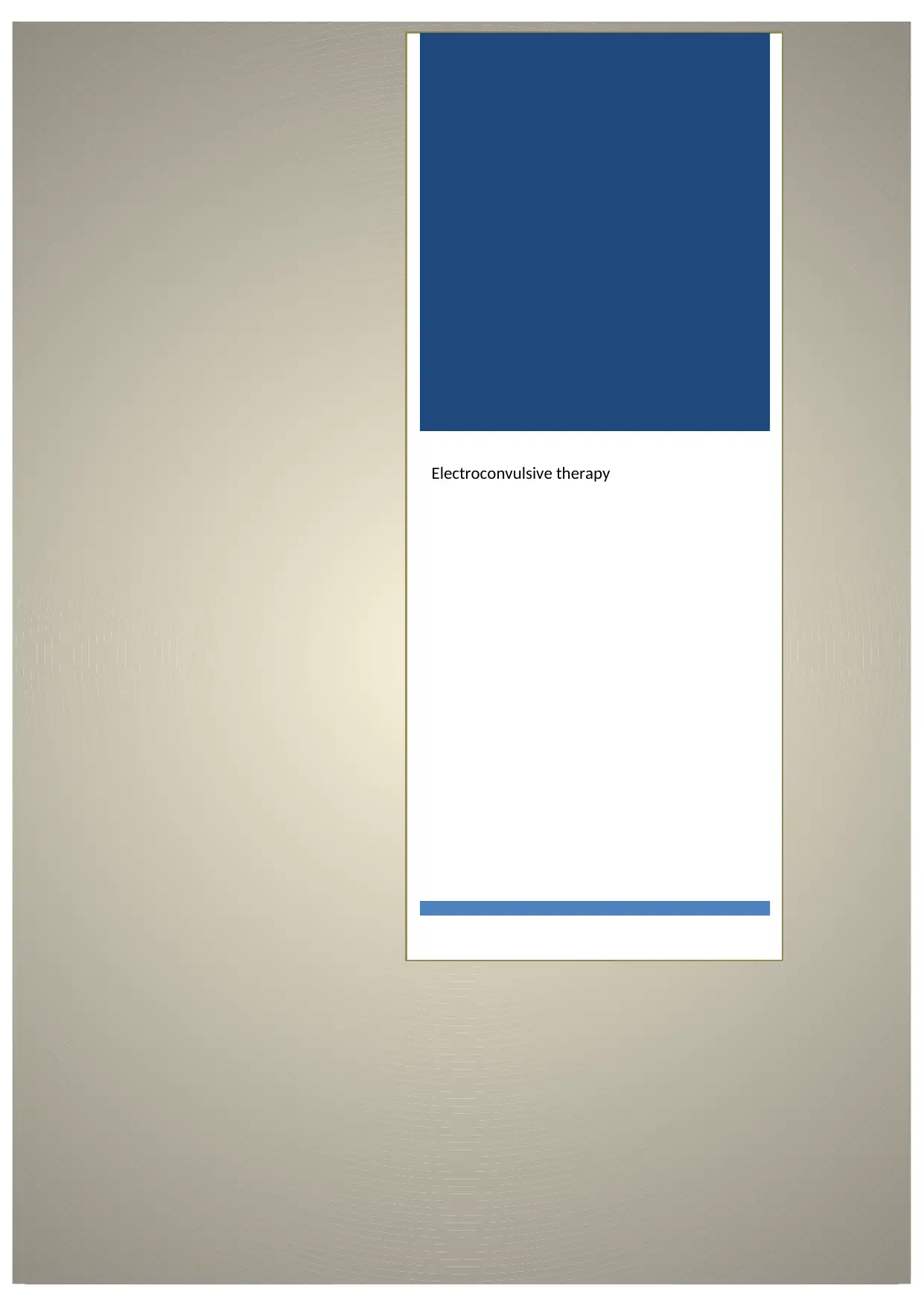
Electroconvulsive therapy
Paraphrase This Document
Need a fresh take? Get an instant paraphrase of this document with our AI Paraphraser
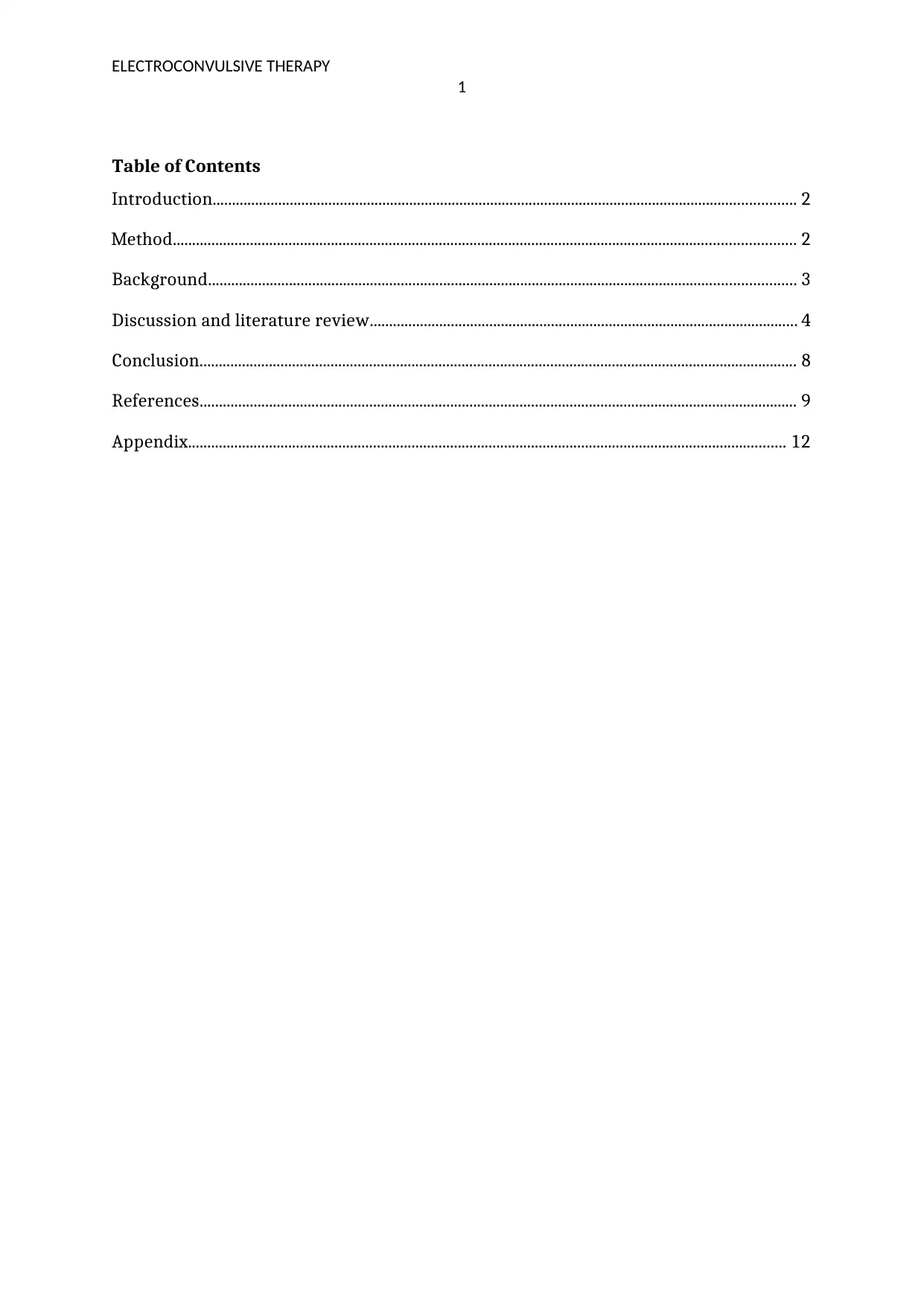
ELECTROCONVULSIVE THERAPY
1
Table of Contents
Introduction....................................................................................................................................................... 2
Method................................................................................................................................................................. 2
Background........................................................................................................................................................ 3
Discussion and literature review............................................................................................................... 4
Conclusion........................................................................................................................................................... 8
References........................................................................................................................................................... 9
Appendix........................................................................................................................................................... 12
1
Table of Contents
Introduction....................................................................................................................................................... 2
Method................................................................................................................................................................. 2
Background........................................................................................................................................................ 3
Discussion and literature review............................................................................................................... 4
Conclusion........................................................................................................................................................... 8
References........................................................................................................................................................... 9
Appendix........................................................................................................................................................... 12
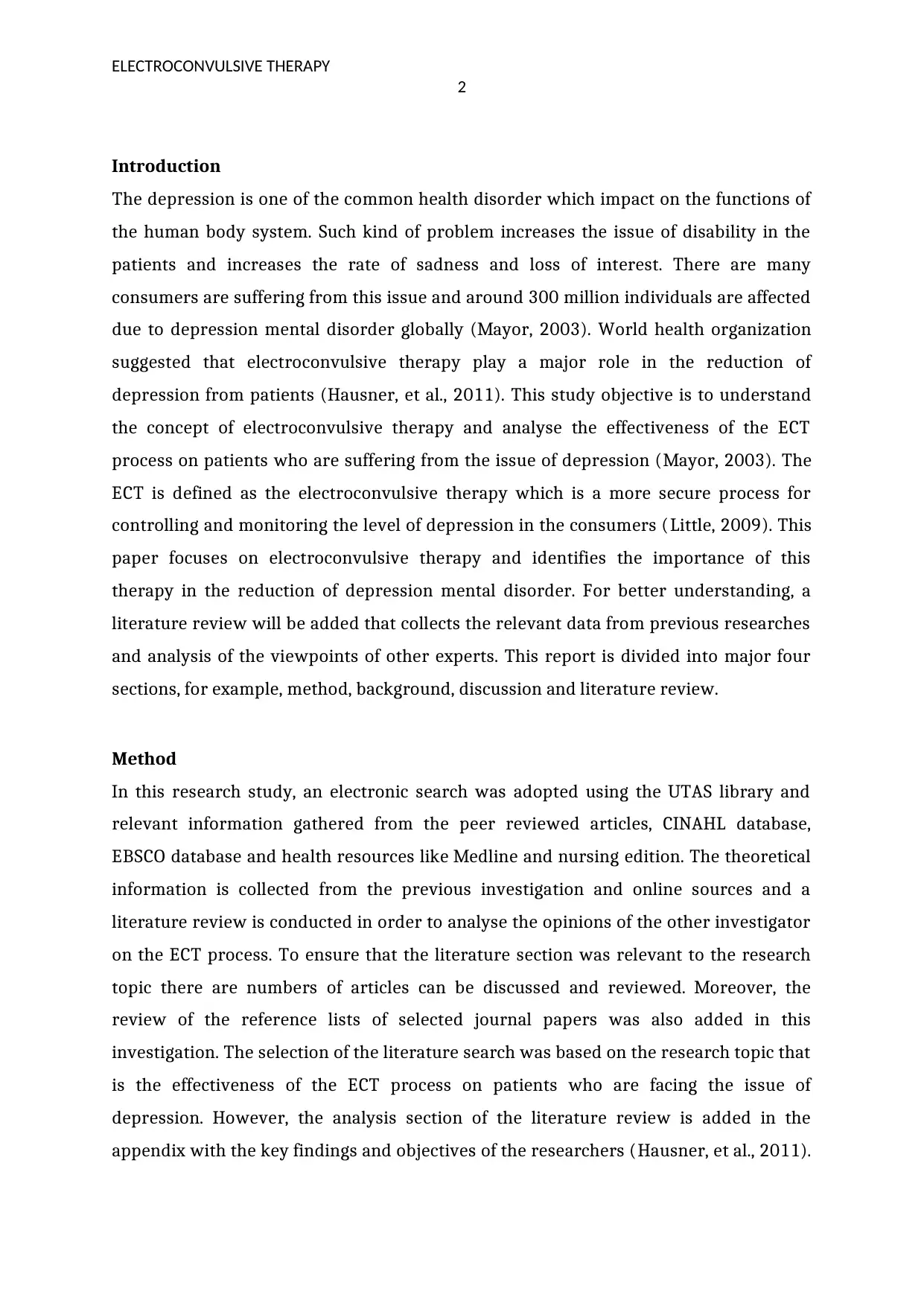
ELECTROCONVULSIVE THERAPY
2
Introduction
The depression is one of the common health disorder which impact on the functions of
the human body system. Such kind of problem increases the issue of disability in the
patients and increases the rate of sadness and loss of interest. There are many
consumers are suffering from this issue and around 300 million individuals are affected
due to depression mental disorder globally (Mayor, 2003). World health organization
suggested that electroconvulsive therapy play a major role in the reduction of
depression from patients (Hausner, et al., 2011). This study objective is to understand
the concept of electroconvulsive therapy and analyse the effectiveness of the ECT
process on patients who are suffering from the issue of depression (Mayor, 2003). The
ECT is defined as the electroconvulsive therapy which is a more secure process for
controlling and monitoring the level of depression in the consumers (Little, 2009). This
paper focuses on electroconvulsive therapy and identifies the importance of this
therapy in the reduction of depression mental disorder. For better understanding, a
literature review will be added that collects the relevant data from previous researches
and analysis of the viewpoints of other experts. This report is divided into major four
sections, for example, method, background, discussion and literature review.
Method
In this research study, an electronic search was adopted using the UTAS library and
relevant information gathered from the peer reviewed articles, CINAHL database,
EBSCO database and health resources like Medline and nursing edition. The theoretical
information is collected from the previous investigation and online sources and a
literature review is conducted in order to analyse the opinions of the other investigator
on the ECT process. To ensure that the literature section was relevant to the research
topic there are numbers of articles can be discussed and reviewed. Moreover, the
review of the reference lists of selected journal papers was also added in this
investigation. The selection of the literature search was based on the research topic that
is the effectiveness of the ECT process on patients who are facing the issue of
depression. However, the analysis section of the literature review is added in the
appendix with the key findings and objectives of the researchers (Hausner, et al., 2011).
2
Introduction
The depression is one of the common health disorder which impact on the functions of
the human body system. Such kind of problem increases the issue of disability in the
patients and increases the rate of sadness and loss of interest. There are many
consumers are suffering from this issue and around 300 million individuals are affected
due to depression mental disorder globally (Mayor, 2003). World health organization
suggested that electroconvulsive therapy play a major role in the reduction of
depression from patients (Hausner, et al., 2011). This study objective is to understand
the concept of electroconvulsive therapy and analyse the effectiveness of the ECT
process on patients who are suffering from the issue of depression (Mayor, 2003). The
ECT is defined as the electroconvulsive therapy which is a more secure process for
controlling and monitoring the level of depression in the consumers (Little, 2009). This
paper focuses on electroconvulsive therapy and identifies the importance of this
therapy in the reduction of depression mental disorder. For better understanding, a
literature review will be added that collects the relevant data from previous researches
and analysis of the viewpoints of other experts. This report is divided into major four
sections, for example, method, background, discussion and literature review.
Method
In this research study, an electronic search was adopted using the UTAS library and
relevant information gathered from the peer reviewed articles, CINAHL database,
EBSCO database and health resources like Medline and nursing edition. The theoretical
information is collected from the previous investigation and online sources and a
literature review is conducted in order to analyse the opinions of the other investigator
on the ECT process. To ensure that the literature section was relevant to the research
topic there are numbers of articles can be discussed and reviewed. Moreover, the
review of the reference lists of selected journal papers was also added in this
investigation. The selection of the literature search was based on the research topic that
is the effectiveness of the ECT process on patients who are facing the issue of
depression. However, the analysis section of the literature review is added in the
appendix with the key findings and objectives of the researchers (Hausner, et al., 2011).
You're viewing a preview
Unlock full access by subscribing today!
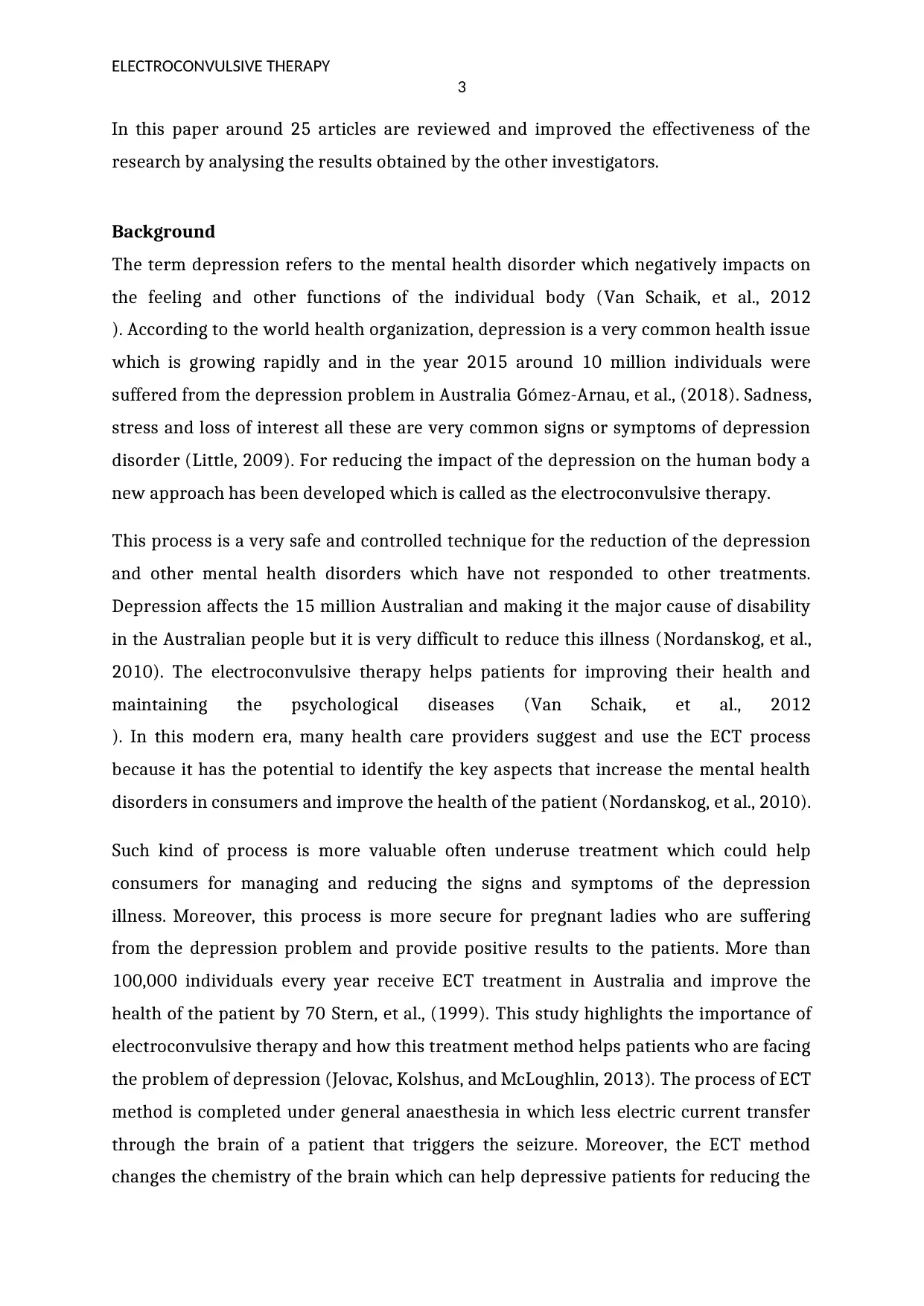
ELECTROCONVULSIVE THERAPY
3
In this paper around 25 articles are reviewed and improved the effectiveness of the
research by analysing the results obtained by the other investigators.
Background
The term depression refers to the mental health disorder which negatively impacts on
the feeling and other functions of the individual body (Van Schaik, et al., 2012
). According to the world health organization, depression is a very common health issue
which is growing rapidly and in the year 2015 around 10 million individuals were
suffered from the depression problem in Australia Gómez-Arnau, et al., (2018). Sadness,
stress and loss of interest all these are very common signs or symptoms of depression
disorder (Little, 2009). For reducing the impact of the depression on the human body a
new approach has been developed which is called as the electroconvulsive therapy.
This process is a very safe and controlled technique for the reduction of the depression
and other mental health disorders which have not responded to other treatments.
Depression affects the 15 million Australian and making it the major cause of disability
in the Australian people but it is very difficult to reduce this illness (Nordanskog, et al.,
2010). The electroconvulsive therapy helps patients for improving their health and
maintaining the psychological diseases (Van Schaik, et al., 2012
). In this modern era, many health care providers suggest and use the ECT process
because it has the potential to identify the key aspects that increase the mental health
disorders in consumers and improve the health of the patient (Nordanskog, et al., 2010).
Such kind of process is more valuable often underuse treatment which could help
consumers for managing and reducing the signs and symptoms of the depression
illness. Moreover, this process is more secure for pregnant ladies who are suffering
from the depression problem and provide positive results to the patients. More than
100,000 individuals every year receive ECT treatment in Australia and improve the
health of the patient by 70 Stern, et al., (1999). This study highlights the importance of
electroconvulsive therapy and how this treatment method helps patients who are facing
the problem of depression (Jelovac, Kolshus, and McLoughlin, 2013). The process of ECT
method is completed under general anaesthesia in which less electric current transfer
through the brain of a patient that triggers the seizure. Moreover, the ECT method
changes the chemistry of the brain which can help depressive patients for reducing the
3
In this paper around 25 articles are reviewed and improved the effectiveness of the
research by analysing the results obtained by the other investigators.
Background
The term depression refers to the mental health disorder which negatively impacts on
the feeling and other functions of the individual body (Van Schaik, et al., 2012
). According to the world health organization, depression is a very common health issue
which is growing rapidly and in the year 2015 around 10 million individuals were
suffered from the depression problem in Australia Gómez-Arnau, et al., (2018). Sadness,
stress and loss of interest all these are very common signs or symptoms of depression
disorder (Little, 2009). For reducing the impact of the depression on the human body a
new approach has been developed which is called as the electroconvulsive therapy.
This process is a very safe and controlled technique for the reduction of the depression
and other mental health disorders which have not responded to other treatments.
Depression affects the 15 million Australian and making it the major cause of disability
in the Australian people but it is very difficult to reduce this illness (Nordanskog, et al.,
2010). The electroconvulsive therapy helps patients for improving their health and
maintaining the psychological diseases (Van Schaik, et al., 2012
). In this modern era, many health care providers suggest and use the ECT process
because it has the potential to identify the key aspects that increase the mental health
disorders in consumers and improve the health of the patient (Nordanskog, et al., 2010).
Such kind of process is more valuable often underuse treatment which could help
consumers for managing and reducing the signs and symptoms of the depression
illness. Moreover, this process is more secure for pregnant ladies who are suffering
from the depression problem and provide positive results to the patients. More than
100,000 individuals every year receive ECT treatment in Australia and improve the
health of the patient by 70 Stern, et al., (1999). This study highlights the importance of
electroconvulsive therapy and how this treatment method helps patients who are facing
the problem of depression (Jelovac, Kolshus, and McLoughlin, 2013). The process of ECT
method is completed under general anaesthesia in which less electric current transfer
through the brain of a patient that triggers the seizure. Moreover, the ECT method
changes the chemistry of the brain which can help depressive patients for reducing the
Paraphrase This Document
Need a fresh take? Get an instant paraphrase of this document with our AI Paraphraser
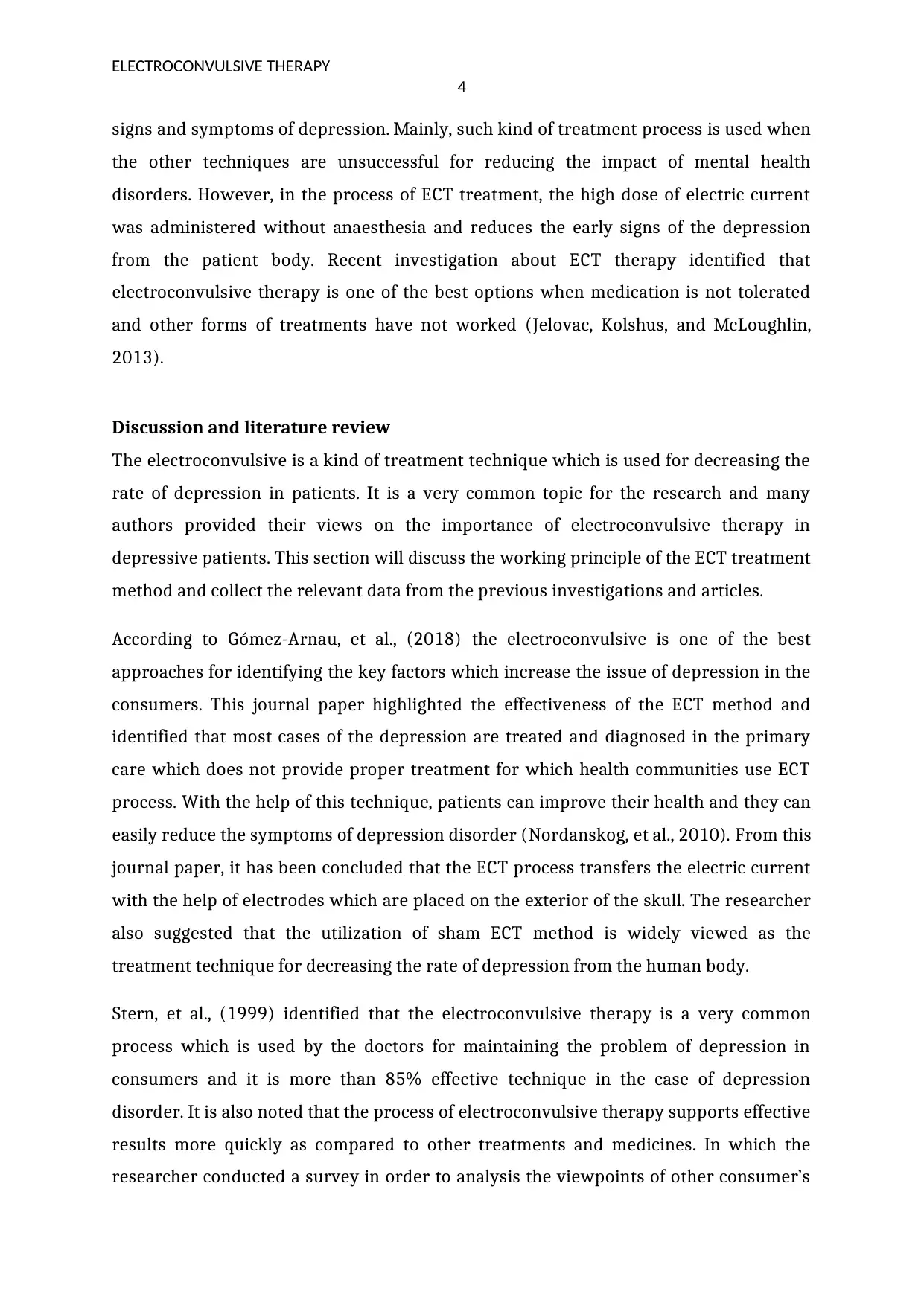
ELECTROCONVULSIVE THERAPY
4
signs and symptoms of depression. Mainly, such kind of treatment process is used when
the other techniques are unsuccessful for reducing the impact of mental health
disorders. However, in the process of ECT treatment, the high dose of electric current
was administered without anaesthesia and reduces the early signs of the depression
from the patient body. Recent investigation about ECT therapy identified that
electroconvulsive therapy is one of the best options when medication is not tolerated
and other forms of treatments have not worked (Jelovac, Kolshus, and McLoughlin,
2013).
Discussion and literature review
The electroconvulsive is a kind of treatment technique which is used for decreasing the
rate of depression in patients. It is a very common topic for the research and many
authors provided their views on the importance of electroconvulsive therapy in
depressive patients. This section will discuss the working principle of the ECT treatment
method and collect the relevant data from the previous investigations and articles.
According to Gómez-Arnau, et al., (2018) the electroconvulsive is one of the best
approaches for identifying the key factors which increase the issue of depression in the
consumers. This journal paper highlighted the effectiveness of the ECT method and
identified that most cases of the depression are treated and diagnosed in the primary
care which does not provide proper treatment for which health communities use ECT
process. With the help of this technique, patients can improve their health and they can
easily reduce the symptoms of depression disorder (Nordanskog, et al., 2010). From this
journal paper, it has been concluded that the ECT process transfers the electric current
with the help of electrodes which are placed on the exterior of the skull. The researcher
also suggested that the utilization of sham ECT method is widely viewed as the
treatment technique for decreasing the rate of depression from the human body.
Stern, et al., (1999) identified that the electroconvulsive therapy is a very common
process which is used by the doctors for maintaining the problem of depression in
consumers and it is more than 85% effective technique in the case of depression
disorder. It is also noted that the process of electroconvulsive therapy supports effective
results more quickly as compared to other treatments and medicines. In which the
researcher conducted a survey in order to analysis the viewpoints of other consumer’s
4
signs and symptoms of depression. Mainly, such kind of treatment process is used when
the other techniques are unsuccessful for reducing the impact of mental health
disorders. However, in the process of ECT treatment, the high dose of electric current
was administered without anaesthesia and reduces the early signs of the depression
from the patient body. Recent investigation about ECT therapy identified that
electroconvulsive therapy is one of the best options when medication is not tolerated
and other forms of treatments have not worked (Jelovac, Kolshus, and McLoughlin,
2013).
Discussion and literature review
The electroconvulsive is a kind of treatment technique which is used for decreasing the
rate of depression in patients. It is a very common topic for the research and many
authors provided their views on the importance of electroconvulsive therapy in
depressive patients. This section will discuss the working principle of the ECT treatment
method and collect the relevant data from the previous investigations and articles.
According to Gómez-Arnau, et al., (2018) the electroconvulsive is one of the best
approaches for identifying the key factors which increase the issue of depression in the
consumers. This journal paper highlighted the effectiveness of the ECT method and
identified that most cases of the depression are treated and diagnosed in the primary
care which does not provide proper treatment for which health communities use ECT
process. With the help of this technique, patients can improve their health and they can
easily reduce the symptoms of depression disorder (Nordanskog, et al., 2010). From this
journal paper, it has been concluded that the ECT process transfers the electric current
with the help of electrodes which are placed on the exterior of the skull. The researcher
also suggested that the utilization of sham ECT method is widely viewed as the
treatment technique for decreasing the rate of depression from the human body.
Stern, et al., (1999) identified that the electroconvulsive therapy is a very common
process which is used by the doctors for maintaining the problem of depression in
consumers and it is more than 85% effective technique in the case of depression
disorder. It is also noted that the process of electroconvulsive therapy supports effective
results more quickly as compared to other treatments and medicines. In which the
researcher conducted a survey in order to analysis the viewpoints of other consumer’s
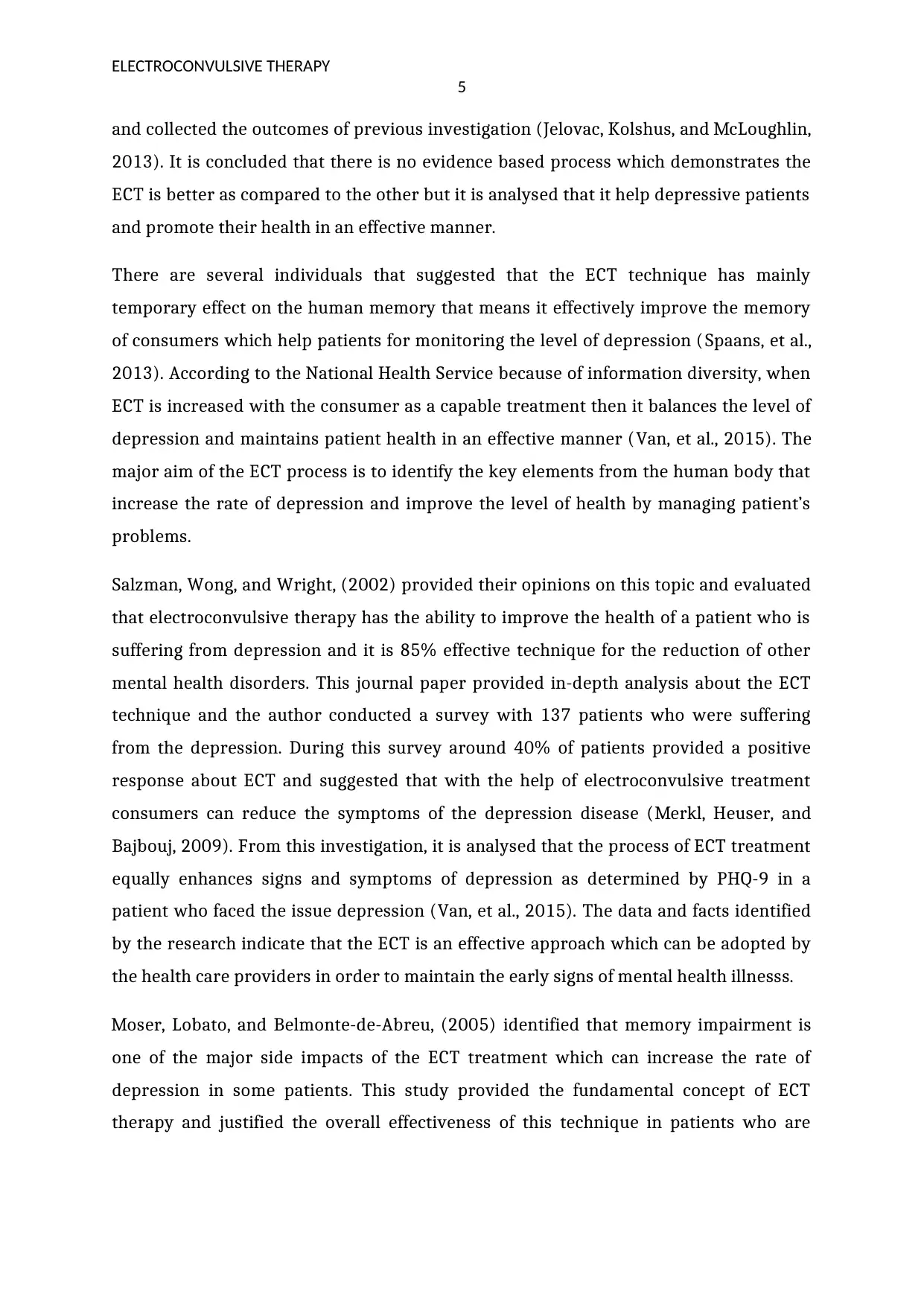
ELECTROCONVULSIVE THERAPY
5
and collected the outcomes of previous investigation (Jelovac, Kolshus, and McLoughlin,
2013). It is concluded that there is no evidence based process which demonstrates the
ECT is better as compared to the other but it is analysed that it help depressive patients
and promote their health in an effective manner.
There are several individuals that suggested that the ECT technique has mainly
temporary effect on the human memory that means it effectively improve the memory
of consumers which help patients for monitoring the level of depression (Spaans, et al.,
2013). According to the National Health Service because of information diversity, when
ECT is increased with the consumer as a capable treatment then it balances the level of
depression and maintains patient health in an effective manner (Van, et al., 2015). The
major aim of the ECT process is to identify the key elements from the human body that
increase the rate of depression and improve the level of health by managing patient’s
problems.
Salzman, Wong, and Wright, (2002) provided their opinions on this topic and evaluated
that electroconvulsive therapy has the ability to improve the health of a patient who is
suffering from depression and it is 85% effective technique for the reduction of other
mental health disorders. This journal paper provided in-depth analysis about the ECT
technique and the author conducted a survey with 137 patients who were suffering
from the depression. During this survey around 40% of patients provided a positive
response about ECT and suggested that with the help of electroconvulsive treatment
consumers can reduce the symptoms of the depression disease (Merkl, Heuser, and
Bajbouj, 2009). From this investigation, it is analysed that the process of ECT treatment
equally enhances signs and symptoms of depression as determined by PHQ-9 in a
patient who faced the issue depression (Van, et al., 2015). The data and facts identified
by the research indicate that the ECT is an effective approach which can be adopted by
the health care providers in order to maintain the early signs of mental health illnesss.
Moser, Lobato, and Belmonte-de-Abreu, (2005) identified that memory impairment is
one of the major side impacts of the ECT treatment which can increase the rate of
depression in some patients. This study provided the fundamental concept of ECT
therapy and justified the overall effectiveness of this technique in patients who are
5
and collected the outcomes of previous investigation (Jelovac, Kolshus, and McLoughlin,
2013). It is concluded that there is no evidence based process which demonstrates the
ECT is better as compared to the other but it is analysed that it help depressive patients
and promote their health in an effective manner.
There are several individuals that suggested that the ECT technique has mainly
temporary effect on the human memory that means it effectively improve the memory
of consumers which help patients for monitoring the level of depression (Spaans, et al.,
2013). According to the National Health Service because of information diversity, when
ECT is increased with the consumer as a capable treatment then it balances the level of
depression and maintains patient health in an effective manner (Van, et al., 2015). The
major aim of the ECT process is to identify the key elements from the human body that
increase the rate of depression and improve the level of health by managing patient’s
problems.
Salzman, Wong, and Wright, (2002) provided their opinions on this topic and evaluated
that electroconvulsive therapy has the ability to improve the health of a patient who is
suffering from depression and it is 85% effective technique for the reduction of other
mental health disorders. This journal paper provided in-depth analysis about the ECT
technique and the author conducted a survey with 137 patients who were suffering
from the depression. During this survey around 40% of patients provided a positive
response about ECT and suggested that with the help of electroconvulsive treatment
consumers can reduce the symptoms of the depression disease (Merkl, Heuser, and
Bajbouj, 2009). From this investigation, it is analysed that the process of ECT treatment
equally enhances signs and symptoms of depression as determined by PHQ-9 in a
patient who faced the issue depression (Van, et al., 2015). The data and facts identified
by the research indicate that the ECT is an effective approach which can be adopted by
the health care providers in order to maintain the early signs of mental health illnesss.
Moser, Lobato, and Belmonte-de-Abreu, (2005) identified that memory impairment is
one of the major side impacts of the ECT treatment which can increase the rate of
depression in some patients. This study provided the fundamental concept of ECT
therapy and justified the overall effectiveness of this technique in patients who are
You're viewing a preview
Unlock full access by subscribing today!
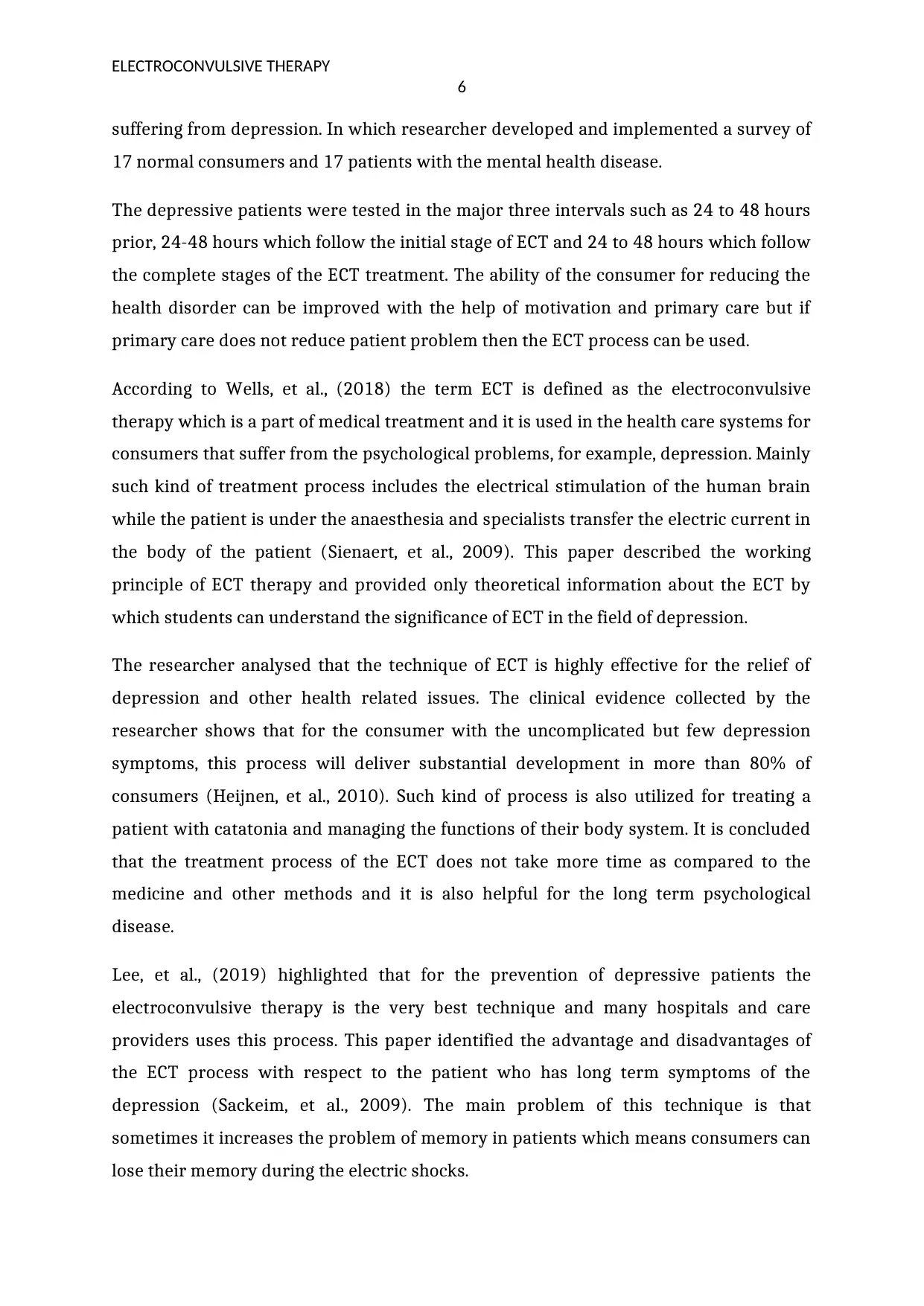
ELECTROCONVULSIVE THERAPY
6
suffering from depression. In which researcher developed and implemented a survey of
17 normal consumers and 17 patients with the mental health disease.
The depressive patients were tested in the major three intervals such as 24 to 48 hours
prior, 24-48 hours which follow the initial stage of ECT and 24 to 48 hours which follow
the complete stages of the ECT treatment. The ability of the consumer for reducing the
health disorder can be improved with the help of motivation and primary care but if
primary care does not reduce patient problem then the ECT process can be used.
According to Wells, et al., (2018) the term ECT is defined as the electroconvulsive
therapy which is a part of medical treatment and it is used in the health care systems for
consumers that suffer from the psychological problems, for example, depression. Mainly
such kind of treatment process includes the electrical stimulation of the human brain
while the patient is under the anaesthesia and specialists transfer the electric current in
the body of the patient (Sienaert, et al., 2009). This paper described the working
principle of ECT therapy and provided only theoretical information about the ECT by
which students can understand the significance of ECT in the field of depression.
The researcher analysed that the technique of ECT is highly effective for the relief of
depression and other health related issues. The clinical evidence collected by the
researcher shows that for the consumer with the uncomplicated but few depression
symptoms, this process will deliver substantial development in more than 80% of
consumers (Heijnen, et al., 2010). Such kind of process is also utilized for treating a
patient with catatonia and managing the functions of their body system. It is concluded
that the treatment process of the ECT does not take more time as compared to the
medicine and other methods and it is also helpful for the long term psychological
disease.
Lee, et al., (2019) highlighted that for the prevention of depressive patients the
electroconvulsive therapy is the very best technique and many hospitals and care
providers uses this process. This paper identified the advantage and disadvantages of
the ECT process with respect to the patient who has long term symptoms of the
depression (Sackeim, et al., 2009). The main problem of this technique is that
sometimes it increases the problem of memory in patients which means consumers can
lose their memory during the electric shocks.
6
suffering from depression. In which researcher developed and implemented a survey of
17 normal consumers and 17 patients with the mental health disease.
The depressive patients were tested in the major three intervals such as 24 to 48 hours
prior, 24-48 hours which follow the initial stage of ECT and 24 to 48 hours which follow
the complete stages of the ECT treatment. The ability of the consumer for reducing the
health disorder can be improved with the help of motivation and primary care but if
primary care does not reduce patient problem then the ECT process can be used.
According to Wells, et al., (2018) the term ECT is defined as the electroconvulsive
therapy which is a part of medical treatment and it is used in the health care systems for
consumers that suffer from the psychological problems, for example, depression. Mainly
such kind of treatment process includes the electrical stimulation of the human brain
while the patient is under the anaesthesia and specialists transfer the electric current in
the body of the patient (Sienaert, et al., 2009). This paper described the working
principle of ECT therapy and provided only theoretical information about the ECT by
which students can understand the significance of ECT in the field of depression.
The researcher analysed that the technique of ECT is highly effective for the relief of
depression and other health related issues. The clinical evidence collected by the
researcher shows that for the consumer with the uncomplicated but few depression
symptoms, this process will deliver substantial development in more than 80% of
consumers (Heijnen, et al., 2010). Such kind of process is also utilized for treating a
patient with catatonia and managing the functions of their body system. It is concluded
that the treatment process of the ECT does not take more time as compared to the
medicine and other methods and it is also helpful for the long term psychological
disease.
Lee, et al., (2019) highlighted that for the prevention of depressive patients the
electroconvulsive therapy is the very best technique and many hospitals and care
providers uses this process. This paper identified the advantage and disadvantages of
the ECT process with respect to the patient who has long term symptoms of the
depression (Sackeim, et al., 2009). The main problem of this technique is that
sometimes it increases the problem of memory in patients which means consumers can
lose their memory during the electric shocks.
Paraphrase This Document
Need a fresh take? Get an instant paraphrase of this document with our AI Paraphraser
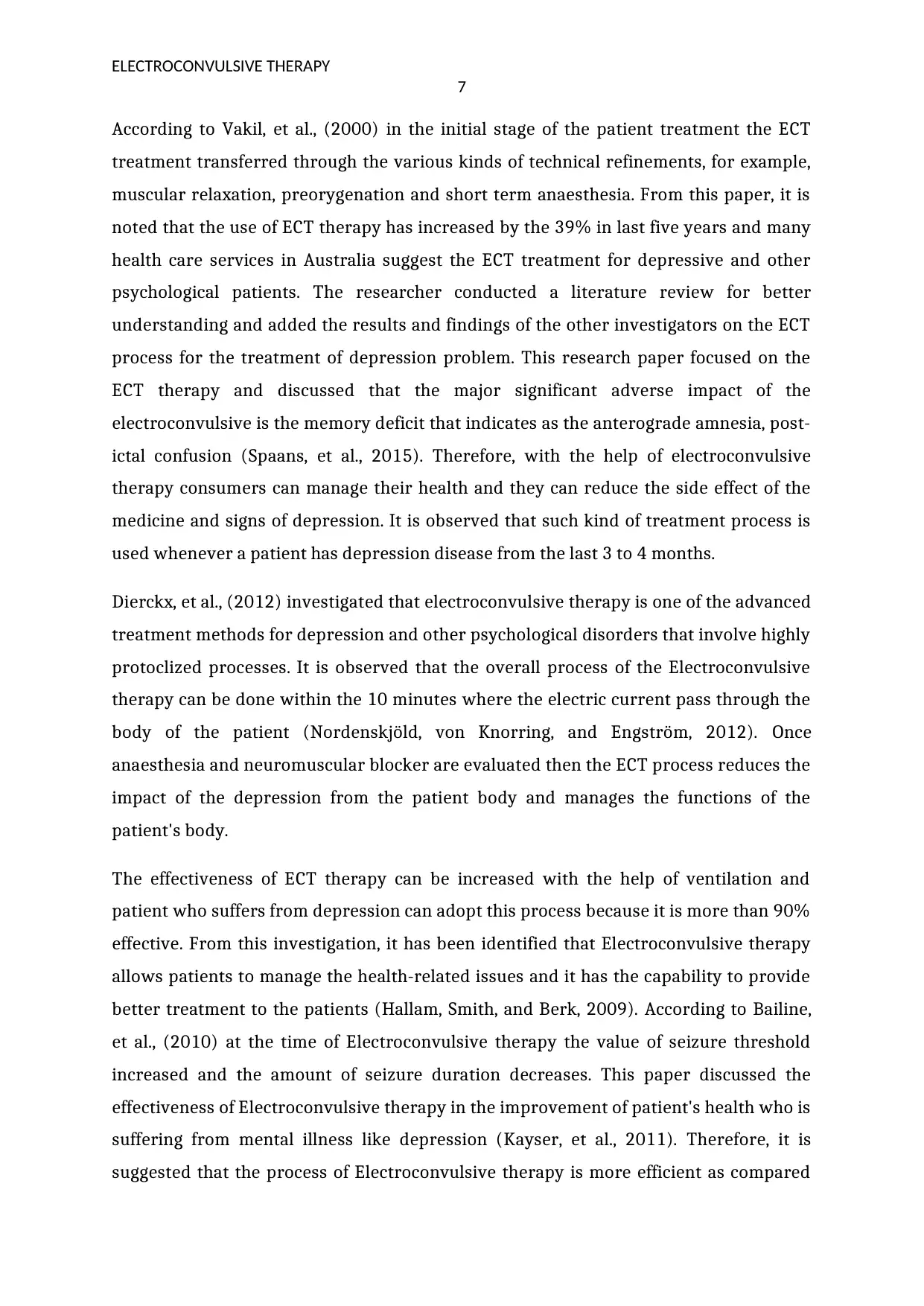
ELECTROCONVULSIVE THERAPY
7
According to Vakil, et al., (2000) in the initial stage of the patient treatment the ECT
treatment transferred through the various kinds of technical refinements, for example,
muscular relaxation, preorygenation and short term anaesthesia. From this paper, it is
noted that the use of ECT therapy has increased by the 39% in last five years and many
health care services in Australia suggest the ECT treatment for depressive and other
psychological patients. The researcher conducted a literature review for better
understanding and added the results and findings of the other investigators on the ECT
process for the treatment of depression problem. This research paper focused on the
ECT therapy and discussed that the major significant adverse impact of the
electroconvulsive is the memory deficit that indicates as the anterograde amnesia, post-
ictal confusion (Spaans, et al., 2015). Therefore, with the help of electroconvulsive
therapy consumers can manage their health and they can reduce the side effect of the
medicine and signs of depression. It is observed that such kind of treatment process is
used whenever a patient has depression disease from the last 3 to 4 months.
Dierckx, et al., (2012) investigated that electroconvulsive therapy is one of the advanced
treatment methods for depression and other psychological disorders that involve highly
protoclized processes. It is observed that the overall process of the Electroconvulsive
therapy can be done within the 10 minutes where the electric current pass through the
body of the patient (Nordenskjöld, von Knorring, and Engström, 2012). Once
anaesthesia and neuromuscular blocker are evaluated then the ECT process reduces the
impact of the depression from the patient body and manages the functions of the
patient's body.
The effectiveness of ECT therapy can be increased with the help of ventilation and
patient who suffers from depression can adopt this process because it is more than 90%
effective. From this investigation, it has been identified that Electroconvulsive therapy
allows patients to manage the health-related issues and it has the capability to provide
better treatment to the patients (Hallam, Smith, and Berk, 2009). According to Bailine,
et al., (2010) at the time of Electroconvulsive therapy the value of seizure threshold
increased and the amount of seizure duration decreases. This paper discussed the
effectiveness of Electroconvulsive therapy in the improvement of patient's health who is
suffering from mental illness like depression (Kayser, et al., 2011). Therefore, it is
suggested that the process of Electroconvulsive therapy is more efficient as compared
7
According to Vakil, et al., (2000) in the initial stage of the patient treatment the ECT
treatment transferred through the various kinds of technical refinements, for example,
muscular relaxation, preorygenation and short term anaesthesia. From this paper, it is
noted that the use of ECT therapy has increased by the 39% in last five years and many
health care services in Australia suggest the ECT treatment for depressive and other
psychological patients. The researcher conducted a literature review for better
understanding and added the results and findings of the other investigators on the ECT
process for the treatment of depression problem. This research paper focused on the
ECT therapy and discussed that the major significant adverse impact of the
electroconvulsive is the memory deficit that indicates as the anterograde amnesia, post-
ictal confusion (Spaans, et al., 2015). Therefore, with the help of electroconvulsive
therapy consumers can manage their health and they can reduce the side effect of the
medicine and signs of depression. It is observed that such kind of treatment process is
used whenever a patient has depression disease from the last 3 to 4 months.
Dierckx, et al., (2012) investigated that electroconvulsive therapy is one of the advanced
treatment methods for depression and other psychological disorders that involve highly
protoclized processes. It is observed that the overall process of the Electroconvulsive
therapy can be done within the 10 minutes where the electric current pass through the
body of the patient (Nordenskjöld, von Knorring, and Engström, 2012). Once
anaesthesia and neuromuscular blocker are evaluated then the ECT process reduces the
impact of the depression from the patient body and manages the functions of the
patient's body.
The effectiveness of ECT therapy can be increased with the help of ventilation and
patient who suffers from depression can adopt this process because it is more than 90%
effective. From this investigation, it has been identified that Electroconvulsive therapy
allows patients to manage the health-related issues and it has the capability to provide
better treatment to the patients (Hallam, Smith, and Berk, 2009). According to Bailine,
et al., (2010) at the time of Electroconvulsive therapy the value of seizure threshold
increased and the amount of seizure duration decreases. This paper discussed the
effectiveness of Electroconvulsive therapy in the improvement of patient's health who is
suffering from mental illness like depression (Kayser, et al., 2011). Therefore, it is
suggested that the process of Electroconvulsive therapy is more efficient as compared
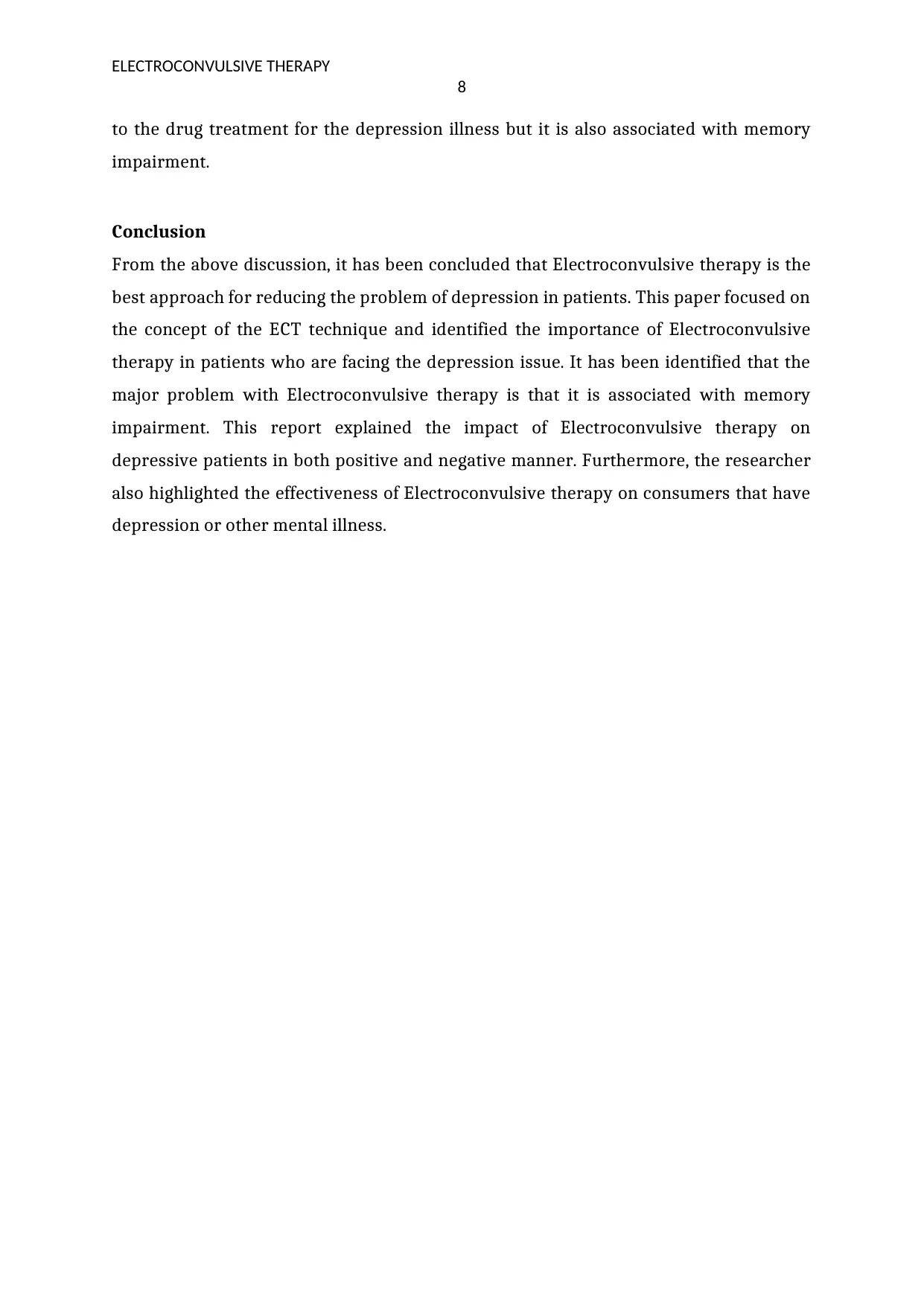
ELECTROCONVULSIVE THERAPY
8
to the drug treatment for the depression illness but it is also associated with memory
impairment.
Conclusion
From the above discussion, it has been concluded that Electroconvulsive therapy is the
best approach for reducing the problem of depression in patients. This paper focused on
the concept of the ECT technique and identified the importance of Electroconvulsive
therapy in patients who are facing the depression issue. It has been identified that the
major problem with Electroconvulsive therapy is that it is associated with memory
impairment. This report explained the impact of Electroconvulsive therapy on
depressive patients in both positive and negative manner. Furthermore, the researcher
also highlighted the effectiveness of Electroconvulsive therapy on consumers that have
depression or other mental illness.
8
to the drug treatment for the depression illness but it is also associated with memory
impairment.
Conclusion
From the above discussion, it has been concluded that Electroconvulsive therapy is the
best approach for reducing the problem of depression in patients. This paper focused on
the concept of the ECT technique and identified the importance of Electroconvulsive
therapy in patients who are facing the depression issue. It has been identified that the
major problem with Electroconvulsive therapy is that it is associated with memory
impairment. This report explained the impact of Electroconvulsive therapy on
depressive patients in both positive and negative manner. Furthermore, the researcher
also highlighted the effectiveness of Electroconvulsive therapy on consumers that have
depression or other mental illness.
You're viewing a preview
Unlock full access by subscribing today!
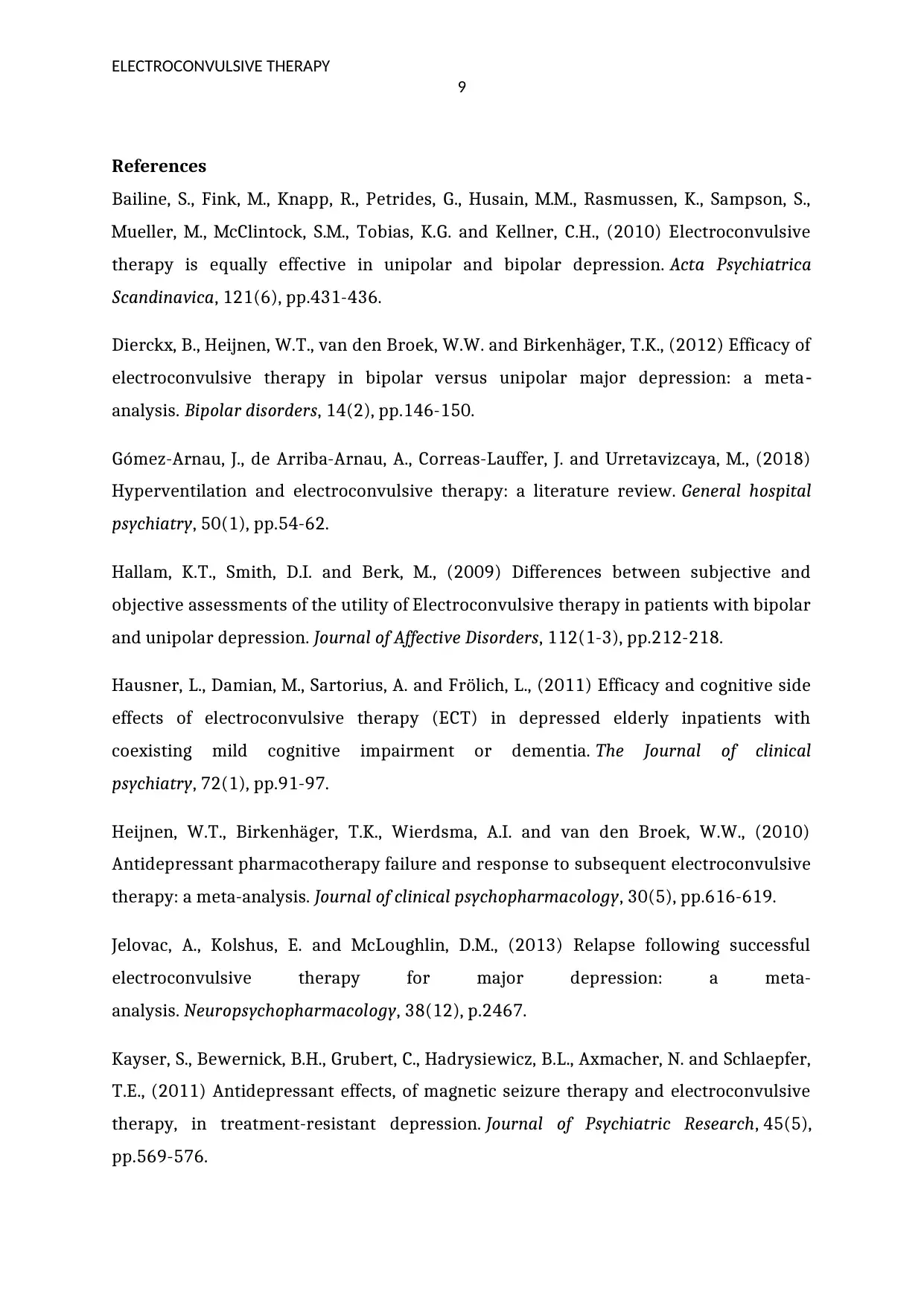
ELECTROCONVULSIVE THERAPY
9
References
Bailine, S., Fink, M., Knapp, R., Petrides, G., Husain, M.M., Rasmussen, K., Sampson, S.,
Mueller, M., McClintock, S.M., Tobias, K.G. and Kellner, C.H., (2010) Electroconvulsive
therapy is equally effective in unipolar and bipolar depression. Acta Psychiatrica
Scandinavica, 121(6), pp.431-436.
Dierckx, B., Heijnen, W.T., van den Broek, W.W. and Birkenhäger, T.K., (2012) Efficacy of
electroconvulsive therapy in bipolar versus unipolar major depression: a meta‐
analysis. Bipolar disorders, 14(2), pp.146-150.
Gómez-Arnau, J., de Arriba-Arnau, A., Correas-Lauffer, J. and Urretavizcaya, M., (2018)
Hyperventilation and electroconvulsive therapy: a literature review. General hospital
psychiatry, 50(1), pp.54-62.
Hallam, K.T., Smith, D.I. and Berk, M., (2009) Differences between subjective and
objective assessments of the utility of Electroconvulsive therapy in patients with bipolar
and unipolar depression. Journal of Affective Disorders, 112(1-3), pp.212-218.
Hausner, L., Damian, M., Sartorius, A. and Frölich, L., (2011) Efficacy and cognitive side
effects of electroconvulsive therapy (ECT) in depressed elderly inpatients with
coexisting mild cognitive impairment or dementia. The Journal of clinical
psychiatry, 72(1), pp.91-97.
Heijnen, W.T., Birkenhäger, T.K., Wierdsma, A.I. and van den Broek, W.W., (2010)
Antidepressant pharmacotherapy failure and response to subsequent electroconvulsive
therapy: a meta-analysis. Journal of clinical psychopharmacology, 30(5), pp.616-619.
Jelovac, A., Kolshus, E. and McLoughlin, D.M., (2013) Relapse following successful
electroconvulsive therapy for major depression: a meta-
analysis. Neuropsychopharmacology, 38(12), p.2467.
Kayser, S., Bewernick, B.H., Grubert, C., Hadrysiewicz, B.L., Axmacher, N. and Schlaepfer,
T.E., (2011) Antidepressant effects, of magnetic seizure therapy and electroconvulsive
therapy, in treatment-resistant depression. Journal of Psychiatric Research, 45(5),
pp.569-576.
9
References
Bailine, S., Fink, M., Knapp, R., Petrides, G., Husain, M.M., Rasmussen, K., Sampson, S.,
Mueller, M., McClintock, S.M., Tobias, K.G. and Kellner, C.H., (2010) Electroconvulsive
therapy is equally effective in unipolar and bipolar depression. Acta Psychiatrica
Scandinavica, 121(6), pp.431-436.
Dierckx, B., Heijnen, W.T., van den Broek, W.W. and Birkenhäger, T.K., (2012) Efficacy of
electroconvulsive therapy in bipolar versus unipolar major depression: a meta‐
analysis. Bipolar disorders, 14(2), pp.146-150.
Gómez-Arnau, J., de Arriba-Arnau, A., Correas-Lauffer, J. and Urretavizcaya, M., (2018)
Hyperventilation and electroconvulsive therapy: a literature review. General hospital
psychiatry, 50(1), pp.54-62.
Hallam, K.T., Smith, D.I. and Berk, M., (2009) Differences between subjective and
objective assessments of the utility of Electroconvulsive therapy in patients with bipolar
and unipolar depression. Journal of Affective Disorders, 112(1-3), pp.212-218.
Hausner, L., Damian, M., Sartorius, A. and Frölich, L., (2011) Efficacy and cognitive side
effects of electroconvulsive therapy (ECT) in depressed elderly inpatients with
coexisting mild cognitive impairment or dementia. The Journal of clinical
psychiatry, 72(1), pp.91-97.
Heijnen, W.T., Birkenhäger, T.K., Wierdsma, A.I. and van den Broek, W.W., (2010)
Antidepressant pharmacotherapy failure and response to subsequent electroconvulsive
therapy: a meta-analysis. Journal of clinical psychopharmacology, 30(5), pp.616-619.
Jelovac, A., Kolshus, E. and McLoughlin, D.M., (2013) Relapse following successful
electroconvulsive therapy for major depression: a meta-
analysis. Neuropsychopharmacology, 38(12), p.2467.
Kayser, S., Bewernick, B.H., Grubert, C., Hadrysiewicz, B.L., Axmacher, N. and Schlaepfer,
T.E., (2011) Antidepressant effects, of magnetic seizure therapy and electroconvulsive
therapy, in treatment-resistant depression. Journal of Psychiatric Research, 45(5),
pp.569-576.
Paraphrase This Document
Need a fresh take? Get an instant paraphrase of this document with our AI Paraphraser
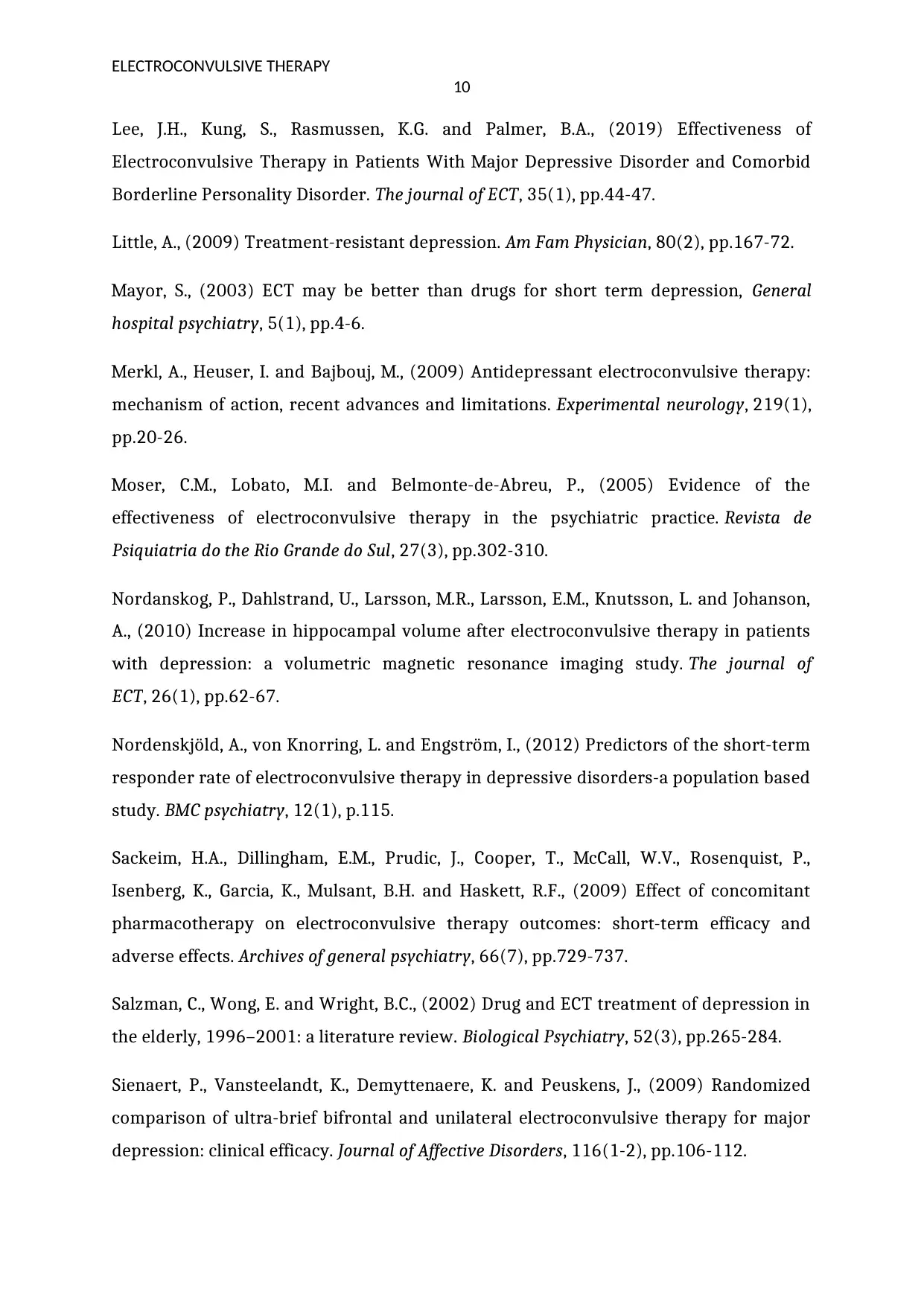
ELECTROCONVULSIVE THERAPY
10
Lee, J.H., Kung, S., Rasmussen, K.G. and Palmer, B.A., (2019) Effectiveness of
Electroconvulsive Therapy in Patients With Major Depressive Disorder and Comorbid
Borderline Personality Disorder. The journal of ECT, 35(1), pp.44-47.
Little, A., (2009) Treatment-resistant depression. Am Fam Physician, 80(2), pp.167-72.
Mayor, S., (2003) ECT may be better than drugs for short term depression, General
hospital psychiatry, 5(1), pp.4-6.
Merkl, A., Heuser, I. and Bajbouj, M., (2009) Antidepressant electroconvulsive therapy:
mechanism of action, recent advances and limitations. Experimental neurology, 219(1),
pp.20-26.
Moser, C.M., Lobato, M.I. and Belmonte-de-Abreu, P., (2005) Evidence of the
effectiveness of electroconvulsive therapy in the psychiatric practice. Revista de
Psiquiatria do the Rio Grande do Sul, 27(3), pp.302-310.
Nordanskog, P., Dahlstrand, U., Larsson, M.R., Larsson, E.M., Knutsson, L. and Johanson,
A., (2010) Increase in hippocampal volume after electroconvulsive therapy in patients
with depression: a volumetric magnetic resonance imaging study. The journal of
ECT, 26(1), pp.62-67.
Nordenskjöld, A., von Knorring, L. and Engström, I., (2012) Predictors of the short-term
responder rate of electroconvulsive therapy in depressive disorders-a population based
study. BMC psychiatry, 12(1), p.115.
Sackeim, H.A., Dillingham, E.M., Prudic, J., Cooper, T., McCall, W.V., Rosenquist, P.,
Isenberg, K., Garcia, K., Mulsant, B.H. and Haskett, R.F., (2009) Effect of concomitant
pharmacotherapy on electroconvulsive therapy outcomes: short-term efficacy and
adverse effects. Archives of general psychiatry, 66(7), pp.729-737.
Salzman, C., Wong, E. and Wright, B.C., (2002) Drug and ECT treatment of depression in
the elderly, 1996–2001: a literature review. Biological Psychiatry, 52(3), pp.265-284.
Sienaert, P., Vansteelandt, K., Demyttenaere, K. and Peuskens, J., (2009) Randomized
comparison of ultra-brief bifrontal and unilateral electroconvulsive therapy for major
depression: clinical efficacy. Journal of Affective Disorders, 116(1-2), pp.106-112.
10
Lee, J.H., Kung, S., Rasmussen, K.G. and Palmer, B.A., (2019) Effectiveness of
Electroconvulsive Therapy in Patients With Major Depressive Disorder and Comorbid
Borderline Personality Disorder. The journal of ECT, 35(1), pp.44-47.
Little, A., (2009) Treatment-resistant depression. Am Fam Physician, 80(2), pp.167-72.
Mayor, S., (2003) ECT may be better than drugs for short term depression, General
hospital psychiatry, 5(1), pp.4-6.
Merkl, A., Heuser, I. and Bajbouj, M., (2009) Antidepressant electroconvulsive therapy:
mechanism of action, recent advances and limitations. Experimental neurology, 219(1),
pp.20-26.
Moser, C.M., Lobato, M.I. and Belmonte-de-Abreu, P., (2005) Evidence of the
effectiveness of electroconvulsive therapy in the psychiatric practice. Revista de
Psiquiatria do the Rio Grande do Sul, 27(3), pp.302-310.
Nordanskog, P., Dahlstrand, U., Larsson, M.R., Larsson, E.M., Knutsson, L. and Johanson,
A., (2010) Increase in hippocampal volume after electroconvulsive therapy in patients
with depression: a volumetric magnetic resonance imaging study. The journal of
ECT, 26(1), pp.62-67.
Nordenskjöld, A., von Knorring, L. and Engström, I., (2012) Predictors of the short-term
responder rate of electroconvulsive therapy in depressive disorders-a population based
study. BMC psychiatry, 12(1), p.115.
Sackeim, H.A., Dillingham, E.M., Prudic, J., Cooper, T., McCall, W.V., Rosenquist, P.,
Isenberg, K., Garcia, K., Mulsant, B.H. and Haskett, R.F., (2009) Effect of concomitant
pharmacotherapy on electroconvulsive therapy outcomes: short-term efficacy and
adverse effects. Archives of general psychiatry, 66(7), pp.729-737.
Salzman, C., Wong, E. and Wright, B.C., (2002) Drug and ECT treatment of depression in
the elderly, 1996–2001: a literature review. Biological Psychiatry, 52(3), pp.265-284.
Sienaert, P., Vansteelandt, K., Demyttenaere, K. and Peuskens, J., (2009) Randomized
comparison of ultra-brief bifrontal and unilateral electroconvulsive therapy for major
depression: clinical efficacy. Journal of Affective Disorders, 116(1-2), pp.106-112.

ELECTROCONVULSIVE THERAPY
11
Spaans, H.P., Sienaert, P., Bouckaert, F., van den Berg, J.F., Verwijk, E., Kho, K.H., Stek,
M.L. and Kok, R.M., (2015) Speed of remission in elderly patients with depression:
electroconvulsive therapy v. medication. The British Journal of Psychiatry, 206(1), pp.67-
71.
Spaans, H.P., Verwijk, E., Comijs, H.C., Kok, R.M., Sienaert, P., Bouckaert, F., Fannes, K.,
Vandepoel, K., Scherder, E.J., Stek, M.L. and Kho, K.H., (2013) Efficacy and cognitive side
effects after brief pulse and ultrabrief pulse right unilateral electroconvulsive therapy
for major depression: a randomized, double-blind, controlled study. The Journal of
clinical psychiatry, 74(11), pp.e1029-36.
Stern, L., Dannon, P.N., Hirschmann, S., Schriber, S., Amytal, D., Dolberg, O.T. and
Grunhaus, L., (1999) Aminophylline increases seizure length during electroconvulsive
therapy. The journal of ECT, 15(4), pp.252-257.
Vakil, E., Grunhaus, L., Nagar, I., Ben-Chaim, E., Dolberg, O.T., Dannon, P.N. and Schreiber,
S., (2000) The effect of electroconvulsive therapy (ECT) on implicit memory: skill
learning and perceptual priming in patients with major
depression. Neuropsychologia, 38(10), pp.1405-1414.
Van Schaik, A.M., Comijs, H.C., Sonnenberg, C.M., Beekman, A.T., Sienaert, P. and Stek,
M.L., (2012) Efficacy and safety of continuation and maintenance electroconvulsive
therapy in depressed elderly patients: a systematic review. The American Journal of
Geriatric Psychiatry, 20(1), pp.5-17.
Van Waarde, J.A., Scholte, H.S., Van Oudheusden, L.J.B., Verwey, B., Denys, D. and Van
Wingen, G.A., (2015) A functional MRI marker may predict the outcome of
electroconvulsive therapy in severe and treatment-resistant depression. Molecular
psychiatry, 20(5), p.609.
Wells, K., Scanlan, J.N., Gomez, L., Rutter, S., Hancock, N., Tuite, A., Ho, J., Jacek, S., Jones,
A., Mehdi, H. and Still, M., (2018) Decision making and support available to individuals
considering and undertaking electroconvulsive therapy (ECT): a qualitative, consumer-
led study. BMC psychiatry, 18(1), p.236.
11
Spaans, H.P., Sienaert, P., Bouckaert, F., van den Berg, J.F., Verwijk, E., Kho, K.H., Stek,
M.L. and Kok, R.M., (2015) Speed of remission in elderly patients with depression:
electroconvulsive therapy v. medication. The British Journal of Psychiatry, 206(1), pp.67-
71.
Spaans, H.P., Verwijk, E., Comijs, H.C., Kok, R.M., Sienaert, P., Bouckaert, F., Fannes, K.,
Vandepoel, K., Scherder, E.J., Stek, M.L. and Kho, K.H., (2013) Efficacy and cognitive side
effects after brief pulse and ultrabrief pulse right unilateral electroconvulsive therapy
for major depression: a randomized, double-blind, controlled study. The Journal of
clinical psychiatry, 74(11), pp.e1029-36.
Stern, L., Dannon, P.N., Hirschmann, S., Schriber, S., Amytal, D., Dolberg, O.T. and
Grunhaus, L., (1999) Aminophylline increases seizure length during electroconvulsive
therapy. The journal of ECT, 15(4), pp.252-257.
Vakil, E., Grunhaus, L., Nagar, I., Ben-Chaim, E., Dolberg, O.T., Dannon, P.N. and Schreiber,
S., (2000) The effect of electroconvulsive therapy (ECT) on implicit memory: skill
learning and perceptual priming in patients with major
depression. Neuropsychologia, 38(10), pp.1405-1414.
Van Schaik, A.M., Comijs, H.C., Sonnenberg, C.M., Beekman, A.T., Sienaert, P. and Stek,
M.L., (2012) Efficacy and safety of continuation and maintenance electroconvulsive
therapy in depressed elderly patients: a systematic review. The American Journal of
Geriatric Psychiatry, 20(1), pp.5-17.
Van Waarde, J.A., Scholte, H.S., Van Oudheusden, L.J.B., Verwey, B., Denys, D. and Van
Wingen, G.A., (2015) A functional MRI marker may predict the outcome of
electroconvulsive therapy in severe and treatment-resistant depression. Molecular
psychiatry, 20(5), p.609.
Wells, K., Scanlan, J.N., Gomez, L., Rutter, S., Hancock, N., Tuite, A., Ho, J., Jacek, S., Jones,
A., Mehdi, H. and Still, M., (2018) Decision making and support available to individuals
considering and undertaking electroconvulsive therapy (ECT): a qualitative, consumer-
led study. BMC psychiatry, 18(1), p.236.
You're viewing a preview
Unlock full access by subscribing today!
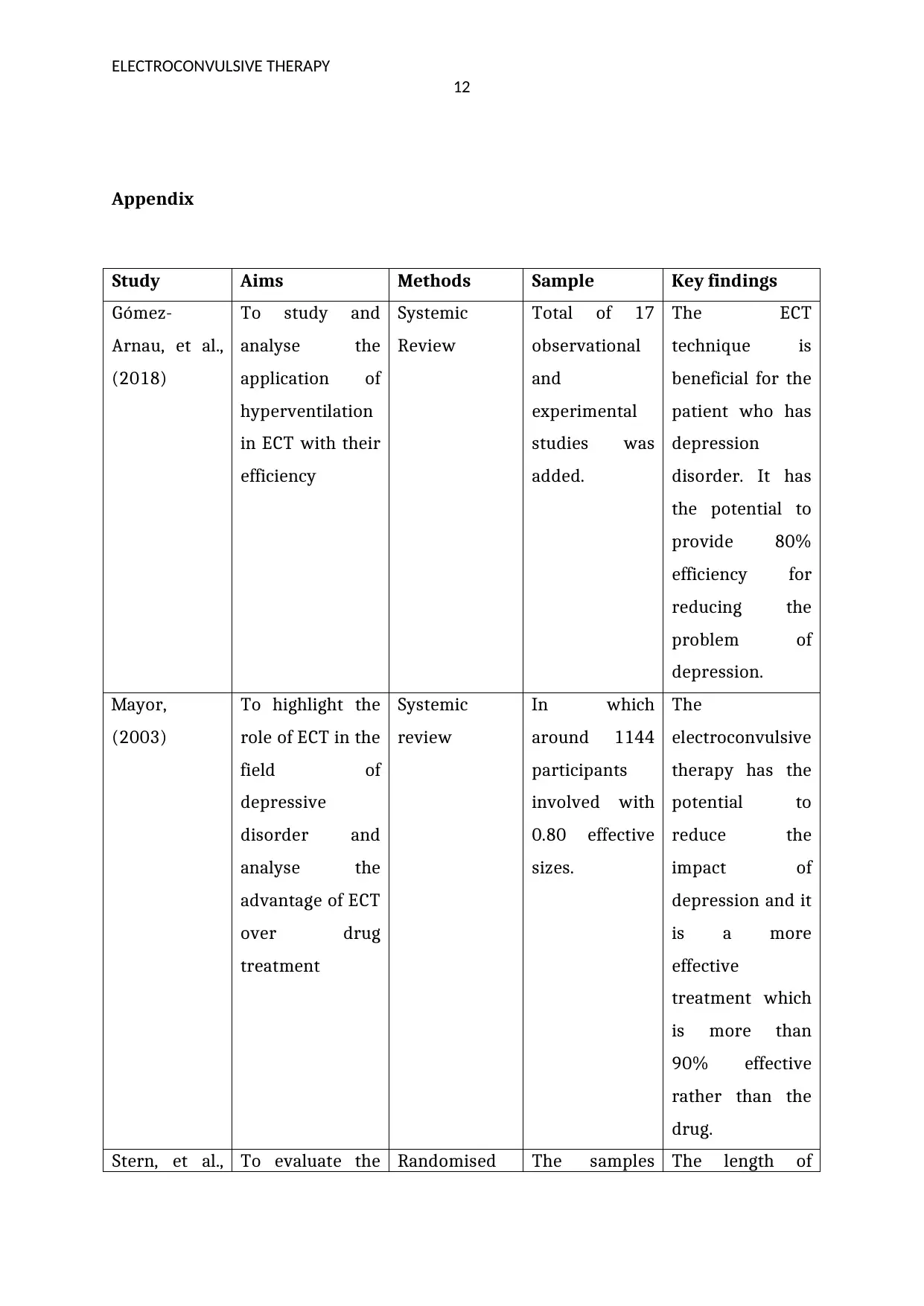
ELECTROCONVULSIVE THERAPY
12
Appendix
Study Aims Methods Sample Key findings
Gómez-
Arnau, et al.,
(2018)
To study and
analyse the
application of
hyperventilation
in ECT with their
efficiency
Systemic
Review
Total of 17
observational
and
experimental
studies was
added.
The ECT
technique is
beneficial for the
patient who has
depression
disorder. It has
the potential to
provide 80%
efficiency for
reducing the
problem of
depression.
Mayor,
(2003)
To highlight the
role of ECT in the
field of
depressive
disorder and
analyse the
advantage of ECT
over drug
treatment
Systemic
review
In which
around 1144
participants
involved with
0.80 effective
sizes.
The
electroconvulsive
therapy has the
potential to
reduce the
impact of
depression and it
is a more
effective
treatment which
is more than
90% effective
rather than the
drug.
Stern, et al., To evaluate the Randomised The samples The length of
12
Appendix
Study Aims Methods Sample Key findings
Gómez-
Arnau, et al.,
(2018)
To study and
analyse the
application of
hyperventilation
in ECT with their
efficiency
Systemic
Review
Total of 17
observational
and
experimental
studies was
added.
The ECT
technique is
beneficial for the
patient who has
depression
disorder. It has
the potential to
provide 80%
efficiency for
reducing the
problem of
depression.
Mayor,
(2003)
To highlight the
role of ECT in the
field of
depressive
disorder and
analyse the
advantage of ECT
over drug
treatment
Systemic
review
In which
around 1144
participants
involved with
0.80 effective
sizes.
The
electroconvulsive
therapy has the
potential to
reduce the
impact of
depression and it
is a more
effective
treatment which
is more than
90% effective
rather than the
drug.
Stern, et al., To evaluate the Randomised The samples The length of
Paraphrase This Document
Need a fresh take? Get an instant paraphrase of this document with our AI Paraphraser
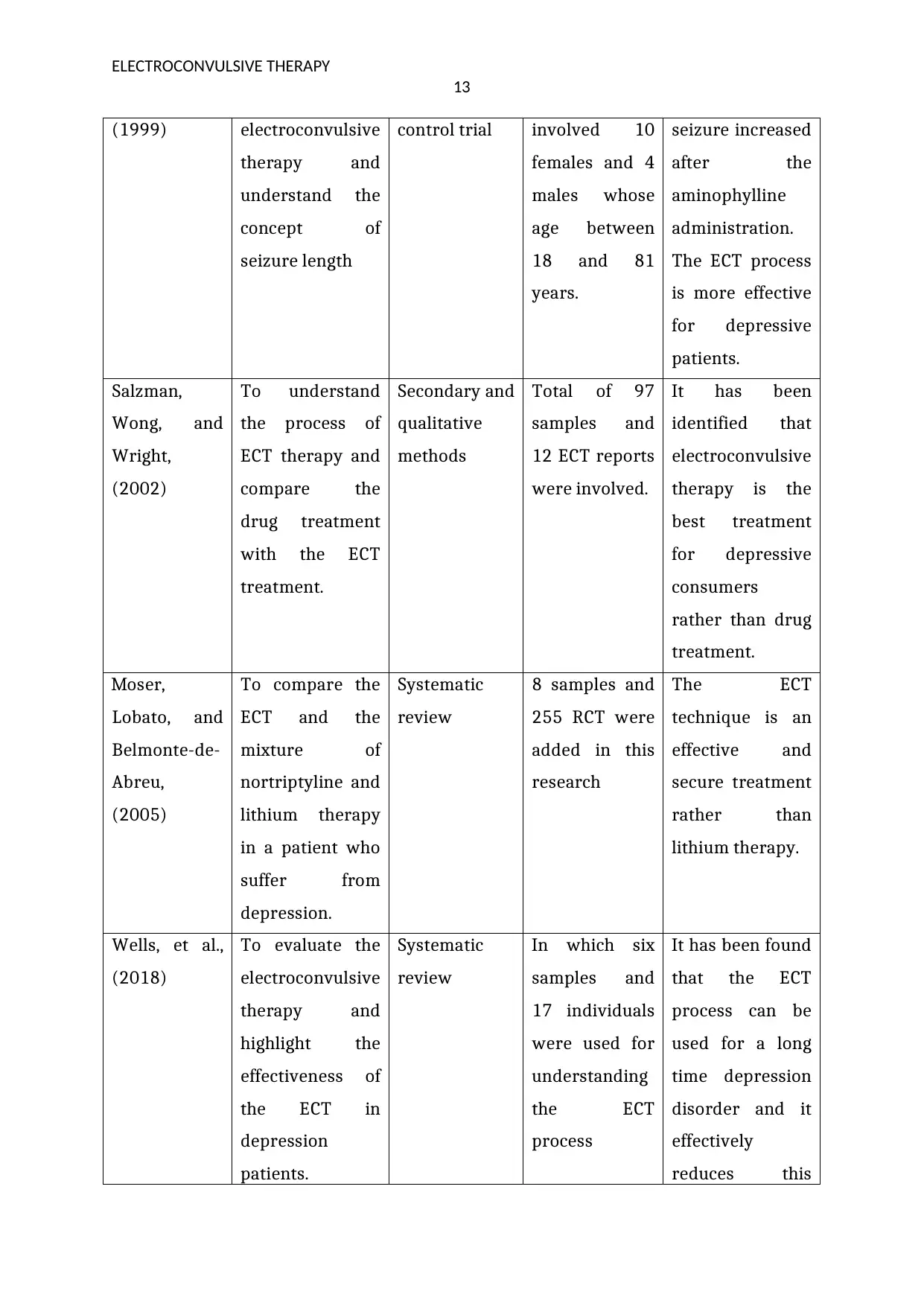
ELECTROCONVULSIVE THERAPY
13
(1999) electroconvulsive
therapy and
understand the
concept of
seizure length
control trial involved 10
females and 4
males whose
age between
18 and 81
years.
seizure increased
after the
aminophylline
administration.
The ECT process
is more effective
for depressive
patients.
Salzman,
Wong, and
Wright,
(2002)
To understand
the process of
ECT therapy and
compare the
drug treatment
with the ECT
treatment.
Secondary and
qualitative
methods
Total of 97
samples and
12 ECT reports
were involved.
It has been
identified that
electroconvulsive
therapy is the
best treatment
for depressive
consumers
rather than drug
treatment.
Moser,
Lobato, and
Belmonte-de-
Abreu,
(2005)
To compare the
ECT and the
mixture of
nortriptyline and
lithium therapy
in a patient who
suffer from
depression.
Systematic
review
8 samples and
255 RCT were
added in this
research
The ECT
technique is an
effective and
secure treatment
rather than
lithium therapy.
Wells, et al.,
(2018)
To evaluate the
electroconvulsive
therapy and
highlight the
effectiveness of
the ECT in
depression
patients.
Systematic
review
In which six
samples and
17 individuals
were used for
understanding
the ECT
process
It has been found
that the ECT
process can be
used for a long
time depression
disorder and it
effectively
reduces this
13
(1999) electroconvulsive
therapy and
understand the
concept of
seizure length
control trial involved 10
females and 4
males whose
age between
18 and 81
years.
seizure increased
after the
aminophylline
administration.
The ECT process
is more effective
for depressive
patients.
Salzman,
Wong, and
Wright,
(2002)
To understand
the process of
ECT therapy and
compare the
drug treatment
with the ECT
treatment.
Secondary and
qualitative
methods
Total of 97
samples and
12 ECT reports
were involved.
It has been
identified that
electroconvulsive
therapy is the
best treatment
for depressive
consumers
rather than drug
treatment.
Moser,
Lobato, and
Belmonte-de-
Abreu,
(2005)
To compare the
ECT and the
mixture of
nortriptyline and
lithium therapy
in a patient who
suffer from
depression.
Systematic
review
8 samples and
255 RCT were
added in this
research
The ECT
technique is an
effective and
secure treatment
rather than
lithium therapy.
Wells, et al.,
(2018)
To evaluate the
electroconvulsive
therapy and
highlight the
effectiveness of
the ECT in
depression
patients.
Systematic
review
In which six
samples and
17 individuals
were used for
understanding
the ECT
process
It has been found
that the ECT
process can be
used for a long
time depression
disorder and it
effectively
reduces this
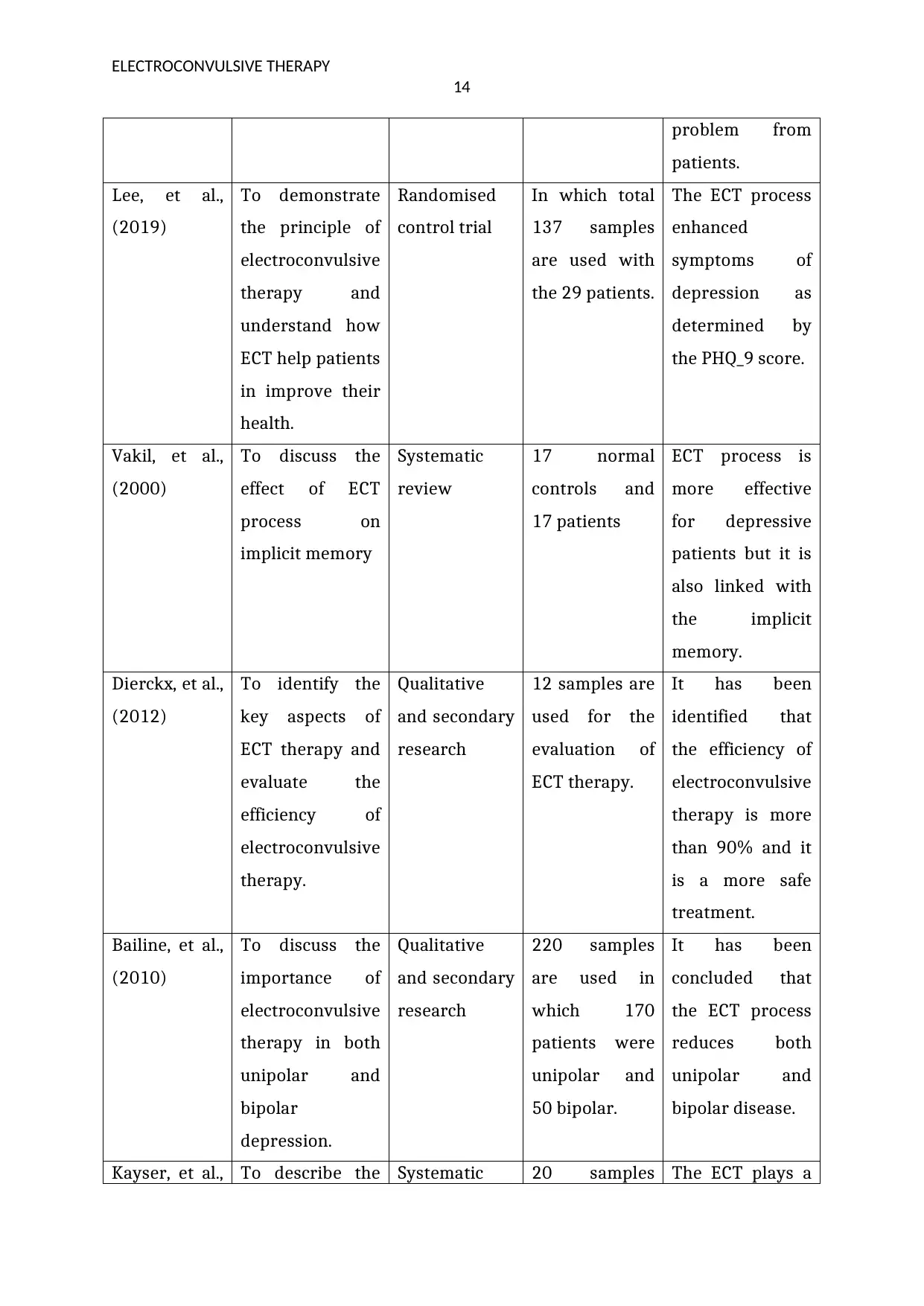
ELECTROCONVULSIVE THERAPY
14
problem from
patients.
Lee, et al.,
(2019)
To demonstrate
the principle of
electroconvulsive
therapy and
understand how
ECT help patients
in improve their
health.
Randomised
control trial
In which total
137 samples
are used with
the 29 patients.
The ECT process
enhanced
symptoms of
depression as
determined by
the PHQ_9 score.
Vakil, et al.,
(2000)
To discuss the
effect of ECT
process on
implicit memory
Systematic
review
17 normal
controls and
17 patients
ECT process is
more effective
for depressive
patients but it is
also linked with
the implicit
memory.
Dierckx, et al.,
(2012)
To identify the
key aspects of
ECT therapy and
evaluate the
efficiency of
electroconvulsive
therapy.
Qualitative
and secondary
research
12 samples are
used for the
evaluation of
ECT therapy.
It has been
identified that
the efficiency of
electroconvulsive
therapy is more
than 90% and it
is a more safe
treatment.
Bailine, et al.,
(2010)
To discuss the
importance of
electroconvulsive
therapy in both
unipolar and
bipolar
depression.
Qualitative
and secondary
research
220 samples
are used in
which 170
patients were
unipolar and
50 bipolar.
It has been
concluded that
the ECT process
reduces both
unipolar and
bipolar disease.
Kayser, et al., To describe the Systematic 20 samples The ECT plays a
14
problem from
patients.
Lee, et al.,
(2019)
To demonstrate
the principle of
electroconvulsive
therapy and
understand how
ECT help patients
in improve their
health.
Randomised
control trial
In which total
137 samples
are used with
the 29 patients.
The ECT process
enhanced
symptoms of
depression as
determined by
the PHQ_9 score.
Vakil, et al.,
(2000)
To discuss the
effect of ECT
process on
implicit memory
Systematic
review
17 normal
controls and
17 patients
ECT process is
more effective
for depressive
patients but it is
also linked with
the implicit
memory.
Dierckx, et al.,
(2012)
To identify the
key aspects of
ECT therapy and
evaluate the
efficiency of
electroconvulsive
therapy.
Qualitative
and secondary
research
12 samples are
used for the
evaluation of
ECT therapy.
It has been
identified that
the efficiency of
electroconvulsive
therapy is more
than 90% and it
is a more safe
treatment.
Bailine, et al.,
(2010)
To discuss the
importance of
electroconvulsive
therapy in both
unipolar and
bipolar
depression.
Qualitative
and secondary
research
220 samples
are used in
which 170
patients were
unipolar and
50 bipolar.
It has been
concluded that
the ECT process
reduces both
unipolar and
bipolar disease.
Kayser, et al., To describe the Systematic 20 samples The ECT plays a
You're viewing a preview
Unlock full access by subscribing today!
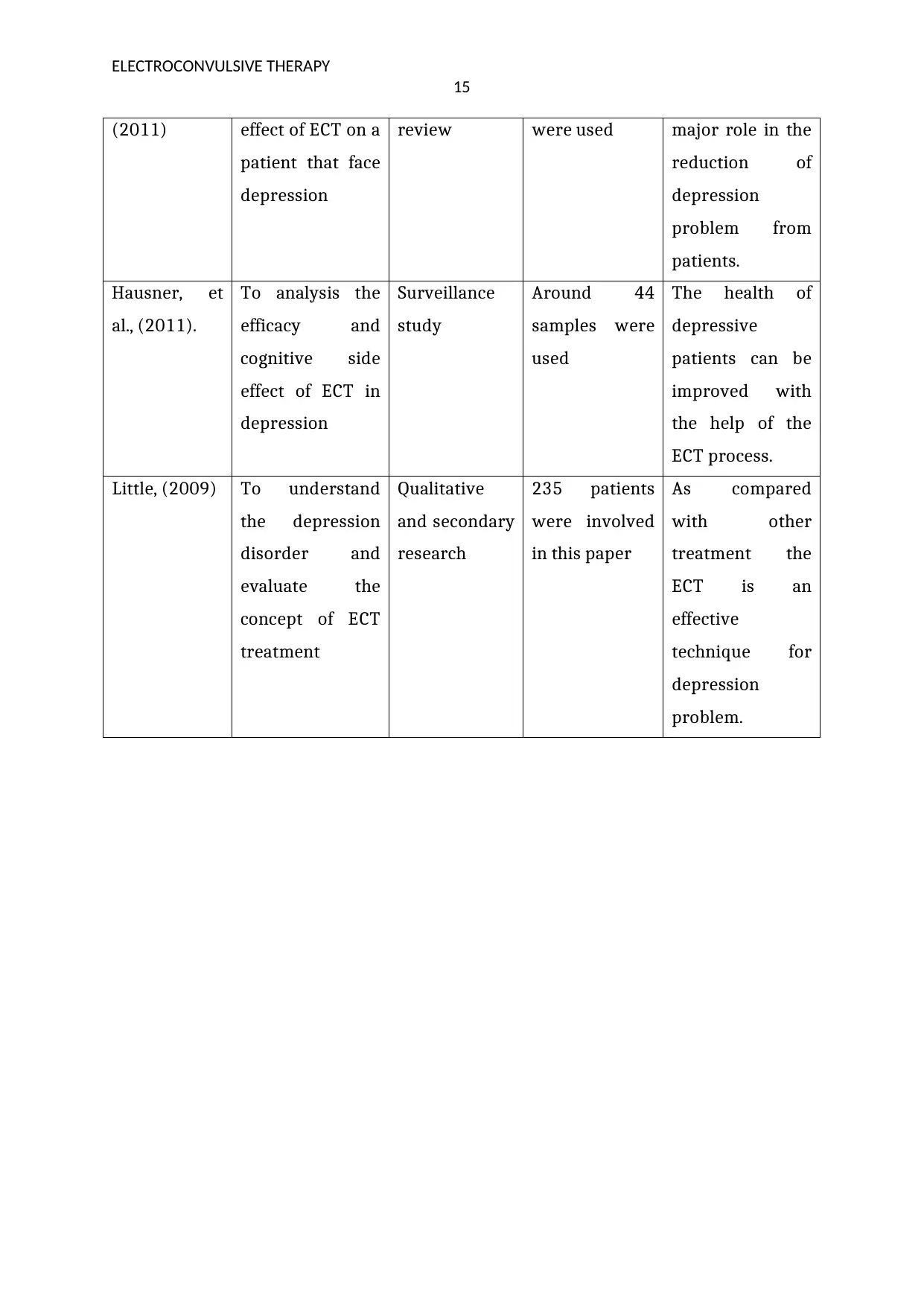
ELECTROCONVULSIVE THERAPY
15
(2011) effect of ECT on a
patient that face
depression
review were used major role in the
reduction of
depression
problem from
patients.
Hausner, et
al., (2011).
To analysis the
efficacy and
cognitive side
effect of ECT in
depression
Surveillance
study
Around 44
samples were
used
The health of
depressive
patients can be
improved with
the help of the
ECT process.
Little, (2009) To understand
the depression
disorder and
evaluate the
concept of ECT
treatment
Qualitative
and secondary
research
235 patients
were involved
in this paper
As compared
with other
treatment the
ECT is an
effective
technique for
depression
problem.
15
(2011) effect of ECT on a
patient that face
depression
review were used major role in the
reduction of
depression
problem from
patients.
Hausner, et
al., (2011).
To analysis the
efficacy and
cognitive side
effect of ECT in
depression
Surveillance
study
Around 44
samples were
used
The health of
depressive
patients can be
improved with
the help of the
ECT process.
Little, (2009) To understand
the depression
disorder and
evaluate the
concept of ECT
treatment
Qualitative
and secondary
research
235 patients
were involved
in this paper
As compared
with other
treatment the
ECT is an
effective
technique for
depression
problem.
1 out of 16
Related Documents
Your All-in-One AI-Powered Toolkit for Academic Success.
+13062052269
info@desklib.com
Available 24*7 on WhatsApp / Email
![[object Object]](/_next/static/media/star-bottom.7253800d.svg)
Unlock your academic potential
© 2024 | Zucol Services PVT LTD | All rights reserved.





